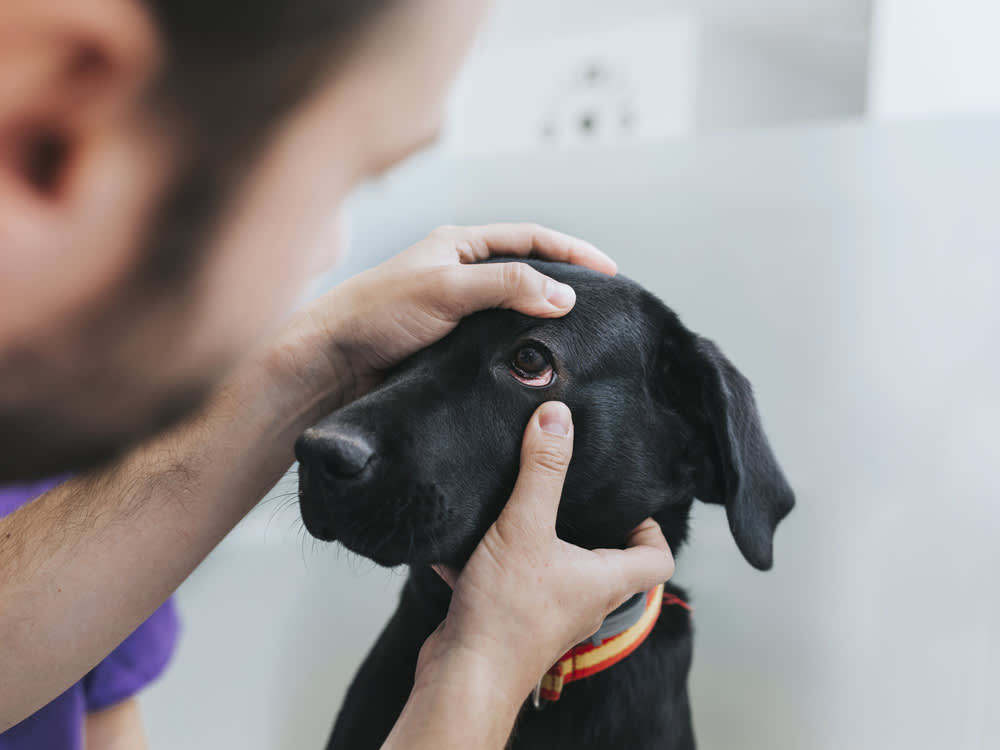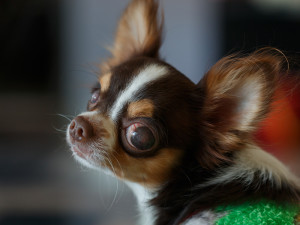Cherry Eye in Dogs: Why Is Your Dog’s Eye So Red?
That would be a cherry eye, and you’ll want to see your vet.

Share Article
In This Article:
What Is Cherry Eye in Dogs? Signs of Cherry Eye What to Do if Your Dog Has Cherry Eye How Is Cherry Eye in Dogs Treated? How to Prevent Cherry Eye in Dogs
There’s nothing like a sudden eye problem to throw a wrench into your weekend plans and have you fretting over your poor pup. Eye problems always seem to pop up out of nowhere, likely because the eyes are so delicate and can quickly go from normal to uh-oh in no time. If you notice that your dog’s eye is red, there are some additional clues that can help you figure out the underlying cause.
Due to the fact that the eyes are so very delicate and also, so very important, it is always best to seek veterinary attention right away if you are not sure what’s going on when it comes to eye problems. Read on to learn about the many possible causes of red eyes in dogs.
What is cherry eye in dogs?
To understand what cherry eye is, it helps to know the structure of your dog’s eyes. Unlike humans, who have two eyelids, dogs have three. The third eyelid rises from the inner corner of the eye and covers the eye diagonally to lubricate it — so it’s important that it functions properly. Cherry eye in dogs occurs when the third eyelid gland slips out of place, creating the appearance of a swollen red mass. The red mass may be constant or transient (meaning it comes and goes). Luckily, it isn’t terribly painful, the symptoms are easy to notice and if treated quickly, there are usually no long-lasting effects. If ignored, surgery may be required to treat cherry eye in order to prevent permanent long-term eye problems in your pup, like decreased tear production.

Dr. Sean Collinsopens in new tab, a clinical assistant professor at the Texas A&M University College of Veterinary Medicine & Biomedical Sciences, says that ophthalmologists don’t entirely understand why that third eyelid sometimes slips from its original position. While any dog breed can develop cherry eye, it is seen most commonly in breeds such as American Cocker Spaniels, Bassett Hounds, Beagles, Boston Terriers, English Bulldogs, Lhasa Apsos, Pekinese, Shih Tzus and other brachycephalic (flat-faced) breeds.
Signs of cherry eye
A pink or red round bulge in the corner of the dog’s eye
Eye irritation, attempts to paw at the eye
Difficulty closing the eye
Eye discharge
What to do if your dog has cherry eye
If you spot a red swollen bulge in the inner corner of your dog’s eye, large or small, call your vet immediately. In addition to causing irritation to the dog, cherry eye can have lasting consequences if left untreated. “Without correction, chronic prolapse can lead to conjunctivitis in dogs (pink eye) and eye discharge,” Dr. Collins explains. “It has also been shown that with correction, dogs are less likely to develop low tear production later in life.”
Low-tear production can result in a set of its own problems — along with decreased vision, your dog may develop a corneal ulceration which can cause an eye infection and result in a ruptured eye. This condition responds well to tear stimulant therapy in most cases, but lifelong medication is usually required. Your veterinarian will be able to confirm whether your pet has cherry eye and can develop a treatment plan that works best to resolve the issue and reduce the potential for future eye issues.
How is cherry eyes in dogs treated?
“Initial therapy may consist of a topical anti-inflammatory,” says Dr. Collins, especially if local inflammation is contributing to the prolapse. He adds that if initial treatment doesn’t work or a prolapse returns, surgery may be required. “There are numerous surgical techniques to reposition the gland with overall high success rates.” If your dog’s cherry eye is transient, your vet may wait until it is in constant prolapse before providing surgical treatment.
The most effective treatment for cherry eyeopens in new tab in dogs involves surgical repositioning of the gland back to its proper location, says veterinarian Dr. Wendy Brooks. There are currently two surgical techniques to do this. The most commonly performed technique is traditional tucking (also called tacking), where a single permanent stitch is placed, pulling the gland back to position. However, in a newer surgical method called imbrication, a wedge of tissue is removed from above the affected gland. This new technique is more challenging and uses several tiny temporary stitches to close the gap.
The third eyelid’s tear gland is responsible for about 30 to 50 percent of the tear production in dogs. If the initial medical therapy is unsuccessful, surgical reposition is key to preserving tear production. In fact, dogs that have undergone surgical repositioning of the gland have a lower chance of developing dry eye than dogs who are chronically prolapsed.
How to prevent cherry eye in dogs
Unfortunately, there are no known preventative measures to avoid cherry eye, per Dr. Collins. About 40 percent of dogs that experience cherry eye will be affected in both eyes, usually before the age of two. The best way to protect your pup from problems is to remain vigilant in monitoring their health, promptly bringing any concerns to your vet. To preserve your dog’s eye health, cherry eye should be addressed early when it’s most easily treated.
If your dog seems to have cherry eye, take them to the vet right away. Your vet may have the knowledge and equipment to diagnose and treat the problem immediately. If not, you may be referred to a veterinary ophthalmologist who specializes in animal eyes and their disorders.
References
Hofve, Jean. “Bright Eyed and Bushy Tailed: Prevent and Treat Conjunctivitis (Aka Pink Eye) Naturally.” Better Nutrition, vol. 77, no. 3, Mar. 2015, pp. 32–34, go.gale.com/ps/i.do?id=GALE%7CA404173123&sid=googleScholar&v=2.1&it=r&linkaccess=abs&issn=0405668X&p=HRCA&sw=w&userGroupName=anon%7E6df7bf8c&aty=open-web-entryopens in new tab. Accessed 29 Jan. 2025.
Peña, Ma Teresa, and Marta Leiva. “Canine Conjunctivitis and Blepharitis.” Veterinary Clinics of North America: Small Animal Practice, vol. 38, no. 2, Mar. 2008, pp. 233–249, https://doi.org/10.1016/j.cvsm.2007.12.001opens in new tab. Accessed 16 July 2020.

Jennifer Gauntt
Jennifer Gauntt, MA, is the communications director at Texas A&M University College of Veterinary Medicine & Biomedical Sciences, where she covers scientific advancements in pet heath and behavior. This story was originally published by Pet Talk, a service of the College of Veterinary Medicine & Biomedical Sciences, Texas A&M University. Original stories can be viewed on the web at vetmed.tamu.edu/news/pet-talkopens in new tab. May be edited for style and length.

Dr. Amy Fox, DVM
Amy Fox, DVM is a small animal veterinarian in New York City with over thirteen years of experience in a mixture of general practice, emergency medicine, and shelter medicine. A lifelong animal lover, Dr. Fox studied biology in college and then worked as a veterinary nurse before pursuing veterinary school at Cornell University. Her expertise includes surgery, dentistry, and management of chronic conditions, and she is interested in toxicology, pain management, nutrition, care of senior pets, and educational outreach. Dr. Fox also enjoys writing about veterinary medicine and teaching, and her work has previously appeared in Spruce Pets. In her free time, she loves to cook, garden, go for long runs, and hang out with her goofy mixed-breed dog May, who provides never ending comic relief!
Related articles
![close up of Chihuahua dog's eye with cataracts]()
Common Eye Problems in Dogs and How to Treat Them
Your dog sees you as their best friend, so keep those eyes healthy.
![Small black pug in a red banana sitting in grass and looking up at camera, dogs eyes getting cloudy]()
Everything You Need to Know About Cataracts in Dogs
Here’s how to spot the eye condition and help your dog see more clearly.
![a dog walking with their parent at night]()
Why Do Dogs’ Eyes Glow in the Dark?
The reason for your midnight jump-scare? Turns out it’s just your dog’s spooky eyes.
![Dog Looking Out The Window.]()
Dog Vision: What Do Dogs See?
Those soulful eyes mean everything to you—learn all about them.
![Sweet young brown labrador with brown eyes on a leash.]()
Why Do Most Dogs Have Brown Eyes?
Someone cue “Brown Eyed [Dog].”
Why Does My Dog Have Eye Boogers?
Next question: Will they let you anywhere near their eyes to wipe off that gunk?







